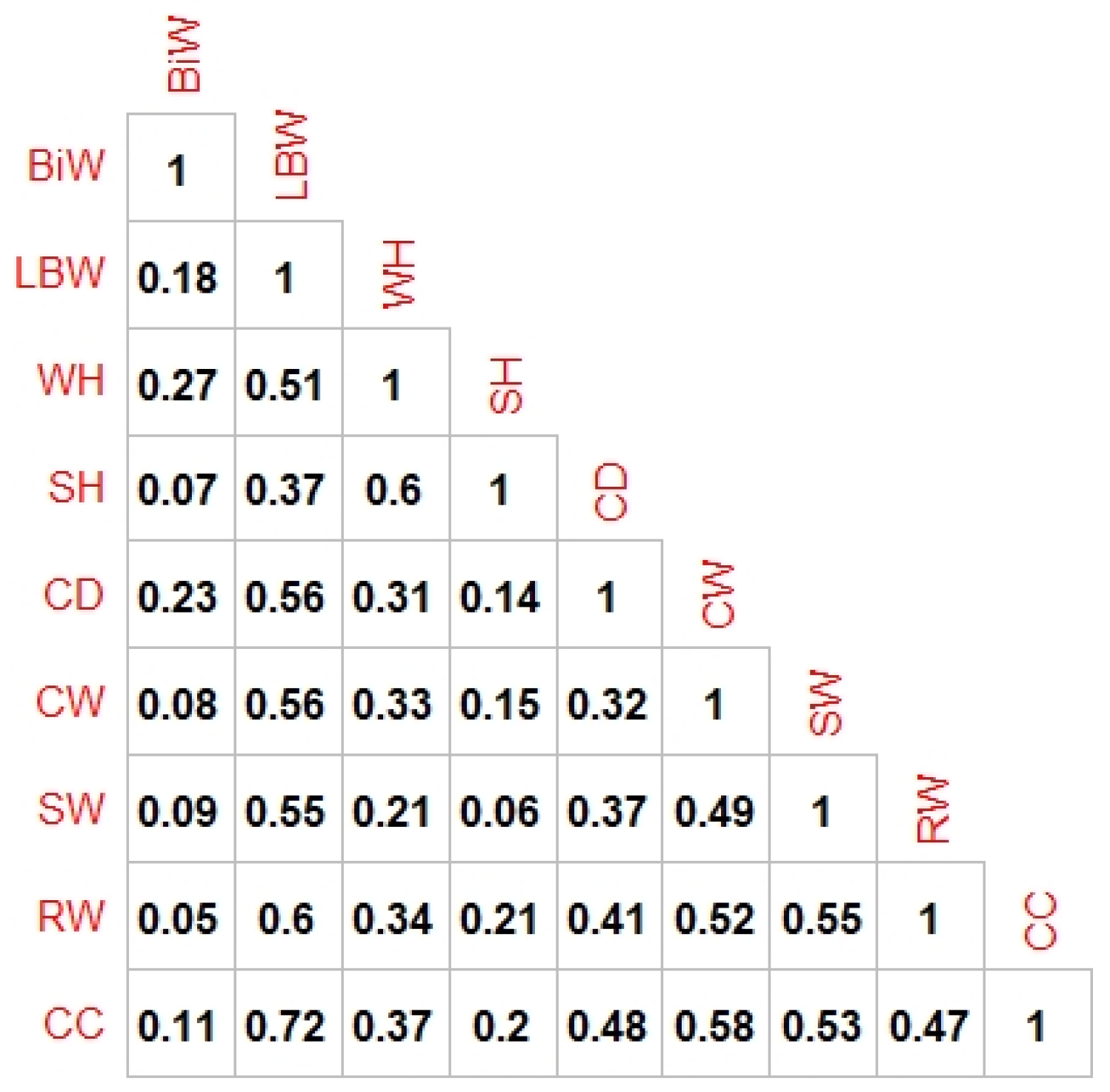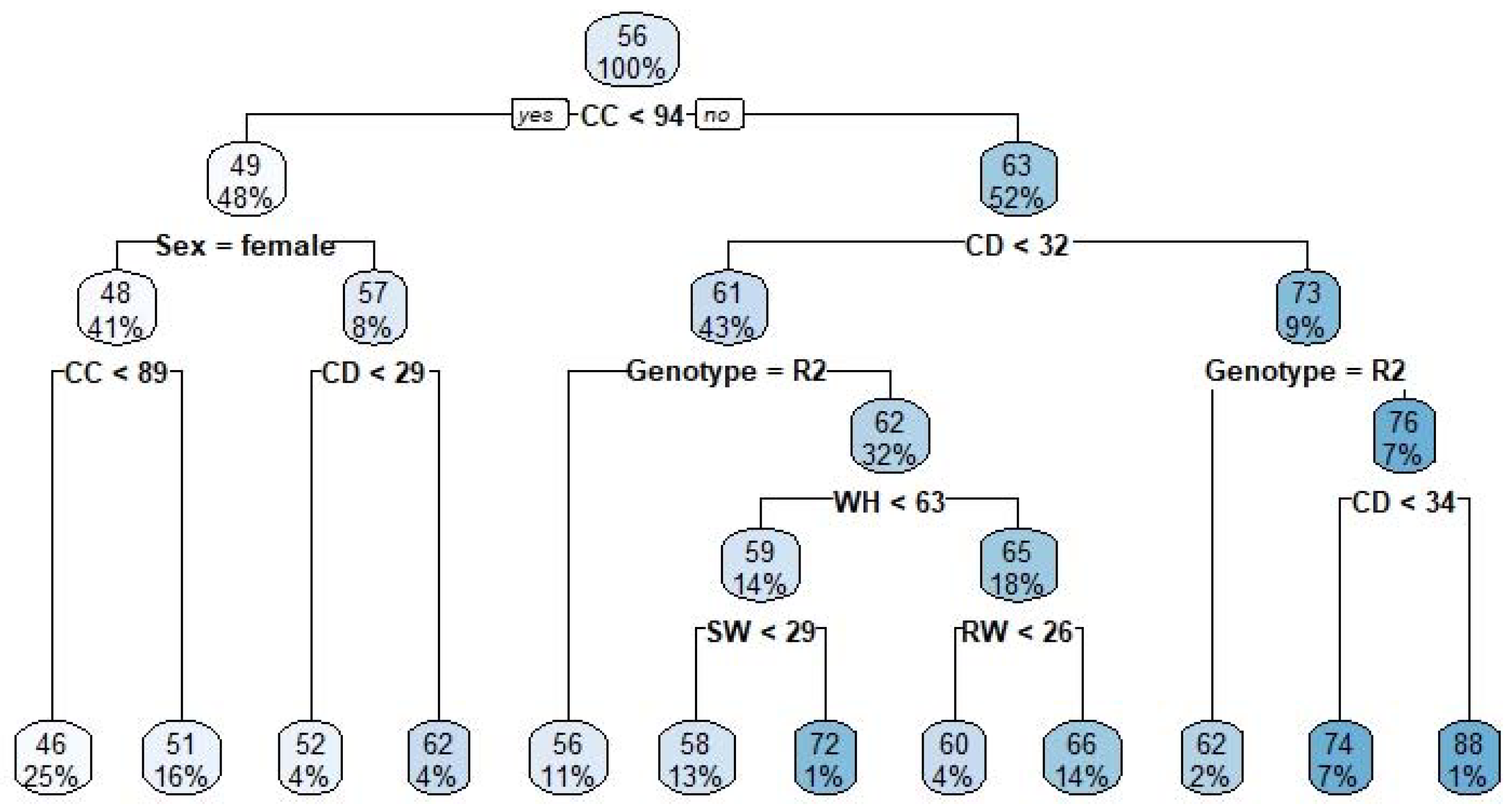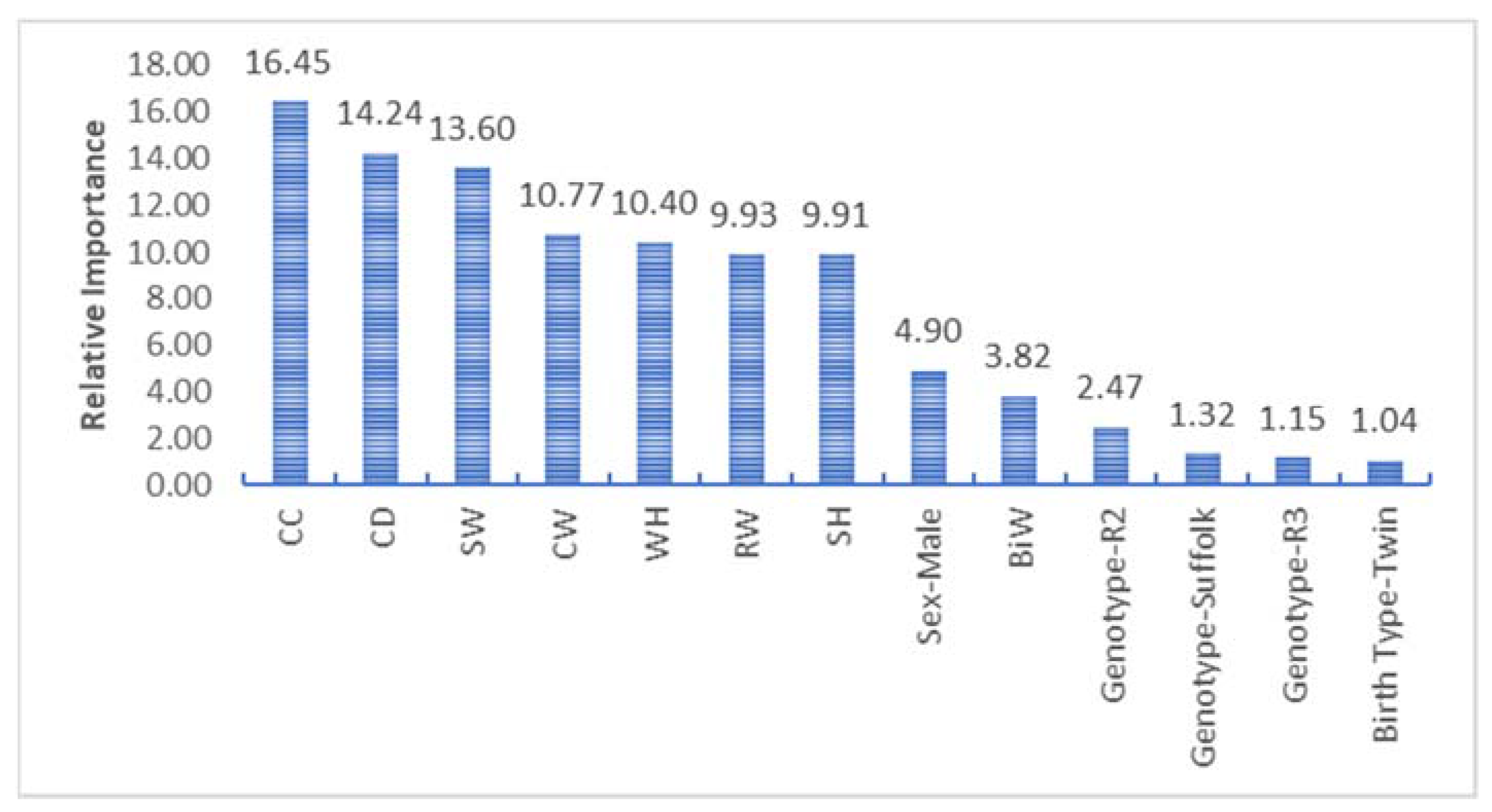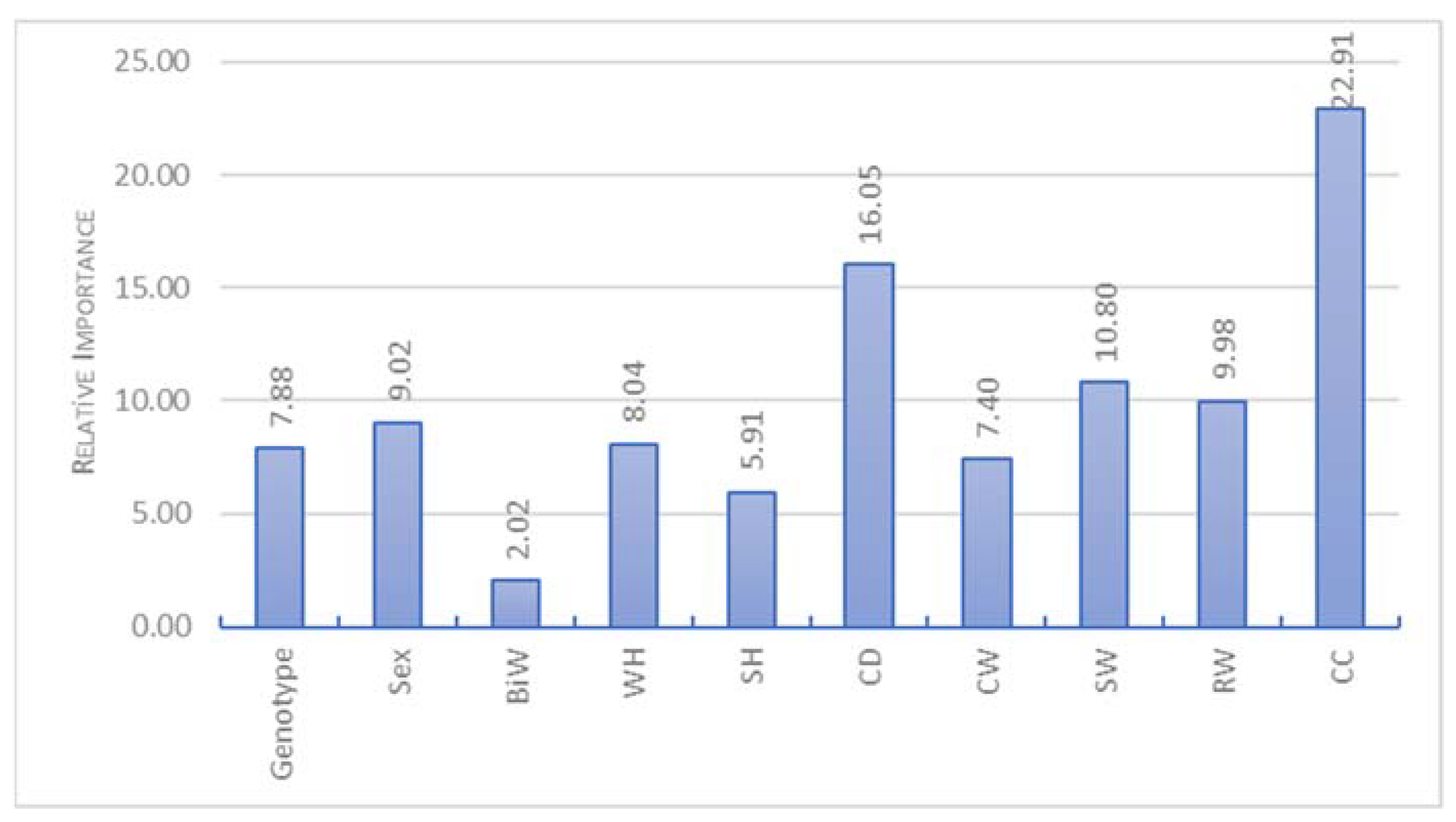Estimation of Body Weight Based on Biometric Measurements by Using Random Forest Regression, Support Vector Regression and CART Algorithms
Abstract
Simple Summary
Abstract
1. Introduction
2. Materials and Methods
- Root-mean-square error (RMSE):
- Akaike information criterion (AIC):
- Standard deviation ratio (SDR):
- Global relative approximation error (RAE):
- Mean absolute percentage error (MAPE):where, n is the number of the training data, yi is the actual amount of the response variable (BW), is the estimated amount for the response variable (BW), Sd is the standard deviation for the response variable (BW) and Sm is the standard deviation of the best model’s errors. The aforementioned goodness of fit was used to compare the model performances, which were made along with the lowest RMSE, SDratio and MAPE. In addition, the model performances evaluated the highest r and R2 values [51].
3. Results
4. Discussion
5. Conclusions
Author Contributions
Funding
Institutional Review Board Statement
Informed Consent Statement
Data Availability Statement
Conflicts of Interest
References
- Celik, S.; Eyduran, E.; Karadas, K.; Tariq, M.M. Comparison of predictive performance of data mining algorithms in predicting body weight in Mengali rams of Pakistan. Braz. J. Anim. Sci. 2017, 46, 863–872. [Google Scholar] [CrossRef]
- Ağyar, O.; Özköse, E.; Ekinci, M.S.; Akyol, İ. Investigation of live weight measurements of morkaraman lambs according to various times in terms of different variables. BSJ Agric. 2020, 3, 193–199. [Google Scholar]
- Polish Union of Sheep-Farmers. Annual Reports: Sheep and Goat Breeding in Poland in 2015 to 2020. Warsaw, Poland. 2016–2021. Available online: http://www.pzow.pl/ (accessed on 20 January 2023). (In Polish).
- Wojtulewicz, B. Animal breeding and production in Poland. In XIV National Animal Breeding in Warsaw; Ministry of Agriculture and Food Economy: Warsaw, Poland, 1998; pp. 1–40. [Google Scholar]
- Piwczyński, D.; Mroczkowski, S. Heritability and breeding value of sheep fertility estimated by means of the linear and threshold model. Sci. Ann. Pol. Soc. Anim. Sci. 2009, 5, 31–39. [Google Scholar]
- Piwczyński, D.; Mroczkowski, S. Body dimensions and conformation indices of crossbreds R2 and R3 derived from back crossing of Polish Merino x Suffolk [Summary in English]. Appl. Sci. Rep. Anim. Prod. Rev. 1998, 37, 63–72. [Google Scholar]
- Polish Union of Sheep-Farmers. Annual Report: Sheep and Goat Breeding in Poland in 2008. Warsaw, Poland. 2009. Available online: http://www.pzow.pl/ (accessed on 20 January 2023). (In Polish).
- Piwczyński, D. Application of classification trees in statistical analysis of ewe prolificacy. Ann. Pol. Soc. Anim. Sci. 2009, 5, 19–29. [Google Scholar]
- Sakar, Ç.M.; Ünal, İ.; Okuroğlu, A.; Coşkum, M.İ.; Zülkadir, U. Prediction of live weight from chest girth from birth to 12 months of age in Yerli Kara cattle. BSJ Agric. 2020, 3, 200–204. [Google Scholar]
- Zhang, A.L.; Wu, B.P.; Wuyun, C.T.; Jiang, D.X.; Xuan, E.C.; Ma, F.Y. Algorithm of sheep body dimension measurement and its applications based on image analysis. Comput. Electron. Agric. 2018, 153, 33–45. [Google Scholar] [CrossRef]
- Eyduran, E.; Karakus, K.; Karakus, S.; Cengiz, F. Usage of factor scores for determining relationships among body weight and some body measurements. Bulg. J. Agric. Sci. 2009, 15, 373–377. [Google Scholar]
- Faraz, A.; Tirink, C.; Eyduran, E.; Waheed, A.; Tauqir, N.A.; Nabeel, M.S.; Tariq, M.M. Prediction of live body weight based on body measurements in Thalli sheep under tropical conditions of Pakistan using CART and MARS. Trop. Anim. Health Prod. 2021, 53, 301. [Google Scholar] [CrossRef]
- Sabbioni, A.; Beretti, V.; Superchi, P.; Ablondi, M. Body weight estimation from body measures in Cornigliese sheep breed. Ital. J. Anim. Sci. 2020, 19, 25–30. [Google Scholar] [CrossRef]
- Eyduran, E.; Zaborski, D.; Waheed, A.; Celik, S.; Karadas, K.; Grzesiak, W. Comparison of the Predictive Capabilities of Several Data Mining Algorithms and Multiple Linear Regression in the Prediction of Body Weight by Means of Body Measurements in the Indigenous Beetal Goat of Pakistan. Pak. J. Zool. 2017, 49, 257–265. [Google Scholar] [CrossRef]
- Khan, M.A.; Tariq, M.M.; Eyduran, E.; Tatliyer, A.; Rafeeq, M.; Abbas, F.; Rashid, N.; Awan, M.A.; Javed, K. Estimating body weight from several body measurements in Harnai sheep without multicollinearity problem. J. Anim. Plant Sci. 2014, 24, 120–126. [Google Scholar]
- Ali, M.; Eyduran, E.; Tariq, M.M.; Tirink, C.; Abbas, F.; Bajwa, M.A.; Baloch, M.H.; Nizamani, A.H.; Waheed, A.; Awan, M.A.; et al. Comparison of artificial neural network and decision tree algorithms used for predicting live weight at post weaning period from some biometrical characteristics in Harnai sheep. Pak. J. Zool. 2015, 47, 1579–1585. [Google Scholar]
- Cam, M.A.; Olfaz, M.; Soydan, E. Body measurements reflect body weights and carcass yields in Karayaka sheep. Asian J. Anim. Vet. Adv. 2010, 5, 120–127. [Google Scholar] [CrossRef]
- Salawu, E.O.; Abdulraheem, M.; Shoyombo, A.; Adepeju, A.; Davies, S.; Akinsola, O.; Nwagu, B. Using Artificial Neural Network to Predict Body Weights of Rabbits. Open J. Anim. Sci. 2014, 4, 182–186. [Google Scholar] [CrossRef]
- Aytekin, I.; Eyduran, E.; Karadas, K.; Aksahan, R.; Keskin, I. Prediction of Fattening Final Live Weight from some Body Measurements and Fattening Period in Young Bulls of Crossbred and Exotic Breeds using MARS Data Mining Algorithm. Pak. J. Zool. 2018, 50, 189–195. [Google Scholar] [CrossRef]
- Celik, S.; Yilmaz, O. Prediction of body weight of Turkish tazi dogs using data mining Techniques: Classification and Regression Tree (CART) and multivariate adaptive regression splines (MARS). Pak. J. Zool. 2018, 50, 575–583. [Google Scholar] [CrossRef]
- Eyduran, E.; Akin, M.; Eyduran, S.P. Application of Multivariate Adaptive Regression Splines through R Software; Nobel Academic Publishing: Ankara, Turkey, 2019. [Google Scholar]
- Ghotbaldini, H.; Mohammadabadi, M.; Nezamabadi-pour, H.; Babenko, O.I.; Bushtruk, M.V.; Tkachenko, S.V. Predicting breeding value of body weight at 6-month age using Artificial Neural Networks in Kermani sheep breed. Acta Sci. Anim. Sci. 2019, 41, e45282. [Google Scholar] [CrossRef]
- Khorshidi-Jalali, M.; Mohammadabadi, M.; Koshkooieh, A.E.; Barazandeh, A.; Babenko, O. Comparison of artificial neural network and regression models for prediction of body weight in Raini Cashmere goat. Iran J. Appl. Anim. Sci. 2019, 9, 453–461. [Google Scholar]
- Olfaz, M.; Tirink, C.; Onder, H. Use of CART and CHAID algorithms in Karayaka sheep breeding. J. Kafkas Univ. Vet. Fak. Derg. 2019, 25, 105–110. [Google Scholar]
- Weber, V.A.M.; de Lima Weber, F.; da Silva Oliveira, A.; Astolfi, G.; Menezes, G.V.; de Andrade Porto, J.V.; Rezende, F.P.C.; de Moraes, P.H.; Matsubara, E.T.; Mateus, R.G.; et al. Cattle weight estimation using active contour models and regression trees Bagging. Comput. Electron. Agric. 2020, 179, 105804. [Google Scholar] [CrossRef]
- Fatih, A.; Celik, S.; Eyduran, E.; Tirink, C.; Tariq, M.M.; Sheikh, I.S.; Faraz, A.; Waheed, A. Use of MARS algorithm for predicting mature weight of different camel (Camelus dromedarius) breeds reared in Pakistan and morphological characterisation via cluster analysis. Trop. Anim. Health Prod. 2021, 53, 191. [Google Scholar] [CrossRef] [PubMed]
- Ağyar, O.; Tırınk, C.; Önder, H.; Şen, U.; Piwczyński, D.; Yavuz, E. Use of Multivariate Adaptive Regression Splines Algorithm to Predict Body Weight from Body Measurements of Anatolian buffaloes in Türkiye. Animals 2022, 12, 2923. [Google Scholar] [CrossRef] [PubMed]
- Uckardes, F.; Efe, E.; Narinc, D.; Aksoy, T. Estimation of the egg albumen index in the Japanese quails with ridge regression method. Akad. Ziraat Derg. 2012, 1, 11–20. [Google Scholar]
- Tırınk, C. Estimating of birth weight using placental characteristics in the presence of multicollinearity. BSJ Eng. Sci. 2020, 3, 138–145. [Google Scholar]
- Topal, M.; Macit, M. Prediction of body weight from body measurements in morkaraman sheep. J. Appl. Anim. Res. 2004, 25, 97–100. [Google Scholar]
- Taye, M.; Bimerow, T.; Yiyayew, A.; Mekuriaw, S.; Mekuriaw, G. Estimation of live body weight from linear body measurements for Farta Sheep. Online J. Anim. Feed Res. 2012, 2, 98–103. [Google Scholar]
- Yakubu, A. Application of regression tree methodology in predicting the body weight of Uda sheep. Anim. Sci. Biotechnol. 2012, 45, 484–490. [Google Scholar]
- Huma, Z.E.; Iqbal, F. Predicting the body weight of Balochi sheep using a machine learning approach. Turk. J. Vet. Anim. Sci. 2019, 43, 500–506. [Google Scholar] [CrossRef]
- Coşkun, G.; Şahin, Ö.; Altay, Y.; Aytekin, İ. Final fattening live weight prediction in Anatolian merinos lambs from some body characteristics at the initial of fattening by using some data mining algorithms. BSJ Agric. 2023, 6, 47–53. [Google Scholar] [CrossRef]
- Piwczyński, D. Effects of the First Stage of Crossing Displacing Suffolk rams x Polish Merino Ewes in Zalesie Flock. Ph.D. Dissertation, University of Technology and Life Science in Bydgoszcz, Bydgoszcz, Poland, 1996; pp. 1–123. (In Polish). [Google Scholar]
- Akin, M.; Eyduran, E.; Niedz, R.P.; Reed, B.M. Developing hazelnut tissue culture free of ion confounding. Plant Cell Tissue Organ Cult. 2017, 13, 483–494. [Google Scholar] [CrossRef]
- Akin, M.; Eyduran, E.; Reed, B.M. Use of RSM and CHAID data mining algorithm for predicting mineral nutrition of hazelnut. Plant Cell Tissue Organ Cult. 2017, 128, 303–316. [Google Scholar] [CrossRef]
- Breiman, L.; Friedman, J.H.; Olshen, R.A.; Stone, C.J. Classification and Regression Trees; Chapman and Hall, Wadsworth Inc.: NewYork, NY, USA, 1984. [Google Scholar]
- Nguyen, Q.T.; Fouchereau, R.; Frénod, E.; Gerard, C. Comparison of forecast models of production of dairy cows combining animal and diet parameters. Comput. Electron. Agric. 2020, 170, 105258. [Google Scholar] [CrossRef]
- Smola, A.J.; Schölkopf, B. A tutorial on support vector regression. Stat. Comput. 2004, 14, 199–222. [Google Scholar] [CrossRef]
- Kavaklioglu, K. Modeling and prediction of Turkey’s electricity consumption using Support Vector Regression. Appl. Energy 2011, 88, 368–375. [Google Scholar] [CrossRef]
- Alonso, J.; Castañón, Á.R.; Bahamonde, A. Support Vector Regression to predict carcass weight in beef cattle in advance of the slaughter. Comput. Electron. Agric. 2013, 91, 116–120. [Google Scholar] [CrossRef]
- Laref, R.; Losson, E.; Sava, A.; Siadat, M. On the optimisation of the support vector machine regression hyperparameters setting for gas sensors array applications. Chemom. Intell. Lab. Syst. 2019, 184, 22–27. [Google Scholar] [CrossRef]
- Patel, A.K.; Chatterjee, S.; Gorai, A.K. Development of a machine vision system using the support vector machine regression (SVR) algorithm for the online prediction of iron ore grades. Earth Sci. Inf. 2019, 12, 197–210. [Google Scholar] [CrossRef]
- Breiman, L. Random forests. Mach. Learn. 2001, 45, 5–32. [Google Scholar] [CrossRef]
- Rodriguez-Galiano, V.; Mendes, M.P.; Garcia-Soldado, M.J.; Chica-Olmo, M.; Riberio, L. Predictive modeling of groundwater nitrate pollution using Random Forest and multisource variables related to intrinsic and specific vulnerability: A case study in an agricultural setting (Southern Spain). Sci. Total Environ. 2014, 467–477, 189–206. [Google Scholar] [CrossRef]
- Wang, L.; Zhou, X.; Zhu, X.; Dong, Z.; Guo, W. Estimation of biomass in wheat using random forest regression algorithm and remote sensing data. Crop J. 2016, 4, 212–219. [Google Scholar] [CrossRef]
- Liaw, A.; Wiener, M. Classification and Regression by randomForest. R News 2002, 2, 18–22. [Google Scholar]
- Grzesiak, W.; Zaborski, D. Examples of the use of data mining methods in animal breeding. In Data Mining Applications in Engineering and Medicine; Karahoca, A., Ed.; IntechOpen: Rijeka, Croatia, 2012; pp. 303–324. [Google Scholar]
- Zaborski, D.; Ali, M.; Eyduran, E.; Grzesiak, W.; Tariq, M.M.; Abbas, F.; Waheed, A.; Tirink, C. Prediction of selected reproductive traits of indigenous Harnai sheep under the farm management system via various data mining algorithms. Pak. J. Zool. 2019, 51, 421–431. [Google Scholar] [CrossRef]
- Tatliyer, A. The Effects of Raising Type on Performances of Some Data Mining Algorithms in Lambs. KSU J. Agric. Nat. 2020, 23, 772–780. [Google Scholar]
- Tırınk, C. Comparison of Bayesian Regularized Neural Network, Random Forest Regression, Support Vector Regression and Multivariate Adaptive Regression Splines Algorithms to Predict Body Weight from Biometrical Measurements in Thalli Sheep. J. Kafkas Univ. Vet. Fak. Derg. 2022, 28, 411–419. [Google Scholar]
- Hussain, S.A.; Cavus, N.; Sekeroglu, B. Hybrid Machine Learning Model for Body Fat Percentage Prediction Based on Support Vector Regression and Emotional Artificial Neural Networks. Appl. Sci. 2021, 11, 9797. [Google Scholar] [CrossRef]
- Iqbal, F.; Waheed, A.; Faraz, A. Comparing the Predictive Ability of Machine Learning Methods in Predicting the Live Body Weight of Beetal Goats of Pakistan. Pak. J. Zool. 2022, 54, 231–238. [Google Scholar] [CrossRef]
- Marco, R.; Ahmad, S.S.S.; Ahmad, S. Bayesian hyperparameter optimisation and Ensemble Learning for Machine Learning Models on software effort estimation. Int. J. Adv. Comput. Sci. Appl. 2022, 13, 419–429. [Google Scholar]
- Ahmad, M.W.; Reynolds, J.; Rezgui, Y. Predictive modelling for solar thermal energy systems: A comparison of support vector regression, random forest, extra trees and regression trees. J. Clean. Prod. 2018, 203, 810–821. [Google Scholar] [CrossRef]




| Genotype | Variables | Mean ± Standard Deviation |
|---|---|---|
| Suffolk N = 133 | BiW | 3.79 ± 0.92 |
| LBW | 58.32 ± 10.32 | |
| WH | 62.07 ± 3.30 | |
| SH | 64.49 ± 4.08 | |
| CD | 28.86 ± 2.47 | |
| CW | 22.95 ± 2.65 | |
| SW | 24.65 ± 2.68 | |
| RR | 26.54 ± 2.96 | |
| CC | 94.16 ± 8.29 | |
| R2 N = 114 | BiW | 4.22 ± 0.82 |
| LBW | 52.70 ± 6.74 | |
| WH | 63.18 ± 2.58 | |
| SH | 63.61 ± 2.45 | |
| CD | 28.50 ± 4.39 | |
| CW | 23.12 ± 2.60 | |
| SW | 22.71 ± 4.39 | |
| RR | 25.20 ± 2.77 | |
| CC | 92.64 ± 6.90 | |
| R3 N = 97 | BiW | 4.13 ± 0.96 |
| LBW | 58.77 ± 11.56 | |
| WH | 62.66 ± 3.34 | |
| SH | 63.35 ± 3.39 | |
| CD | 29.52 ± 2.26 | |
| CW | 23.20 ± 2.50 | |
| SW | 24.90 ± 2.59 | |
| RR | 26.35 ± 2.93 | |
| CC | 95.93 ± 9.30 |
| Criterion | CART | SVR | RFR | |||
|---|---|---|---|---|---|---|
| Training Set | Test Set | Training Set | Test Set | Training Set | Test Set | |
| RMSE | 20.304 | 49.750 | 16.100 | 33.745 | 24.271 | 31.279 |
| SDratio | 0.454 | 0.643 | 0.404 | 0.526 | 0.497 | 0.511 |
| CV | 8.000 | 12.320 | 7.110 | 10.080 | 8.740 | 9.780 |
| r | 0.891 | 0.774 | 0.918 | 0.852 | 0.869 | 0.860 |
| MAPE | 6.643 | 9.801 | 4.984 | 6.822 | 6.848 | 7.046 |
| R2 | 0.793 | 0.578 | 0.836 | 0.714 | 0.753 | 0.735 |
| AIC | 830.985 | 265.677 | 766.951 | 239.280 | 880.245 | 234.121 |
Disclaimer/Publisher’s Note: The statements, opinions and data contained in all publications are solely those of the individual author(s) and contributor(s) and not of MDPI and/or the editor(s). MDPI and/or the editor(s) disclaim responsibility for any injury to people or property resulting from any ideas, methods, instructions or products referred to in the content. |
© 2023 by the authors. Licensee MDPI, Basel, Switzerland. This article is an open access article distributed under the terms and conditions of the Creative Commons Attribution (CC BY) license (https://creativecommons.org/licenses/by/4.0/).
Share and Cite
Tırınk, C.; Piwczyński, D.; Kolenda, M.; Önder, H. Estimation of Body Weight Based on Biometric Measurements by Using Random Forest Regression, Support Vector Regression and CART Algorithms. Animals 2023, 13, 798. https://doi.org/10.3390/ani13050798
Tırınk C, Piwczyński D, Kolenda M, Önder H. Estimation of Body Weight Based on Biometric Measurements by Using Random Forest Regression, Support Vector Regression and CART Algorithms. Animals. 2023; 13(5):798. https://doi.org/10.3390/ani13050798
Chicago/Turabian StyleTırınk, Cem, Dariusz Piwczyński, Magdalena Kolenda, and Hasan Önder. 2023. "Estimation of Body Weight Based on Biometric Measurements by Using Random Forest Regression, Support Vector Regression and CART Algorithms" Animals 13, no. 5: 798. https://doi.org/10.3390/ani13050798
APA StyleTırınk, C., Piwczyński, D., Kolenda, M., & Önder, H. (2023). Estimation of Body Weight Based on Biometric Measurements by Using Random Forest Regression, Support Vector Regression and CART Algorithms. Animals, 13(5), 798. https://doi.org/10.3390/ani13050798





